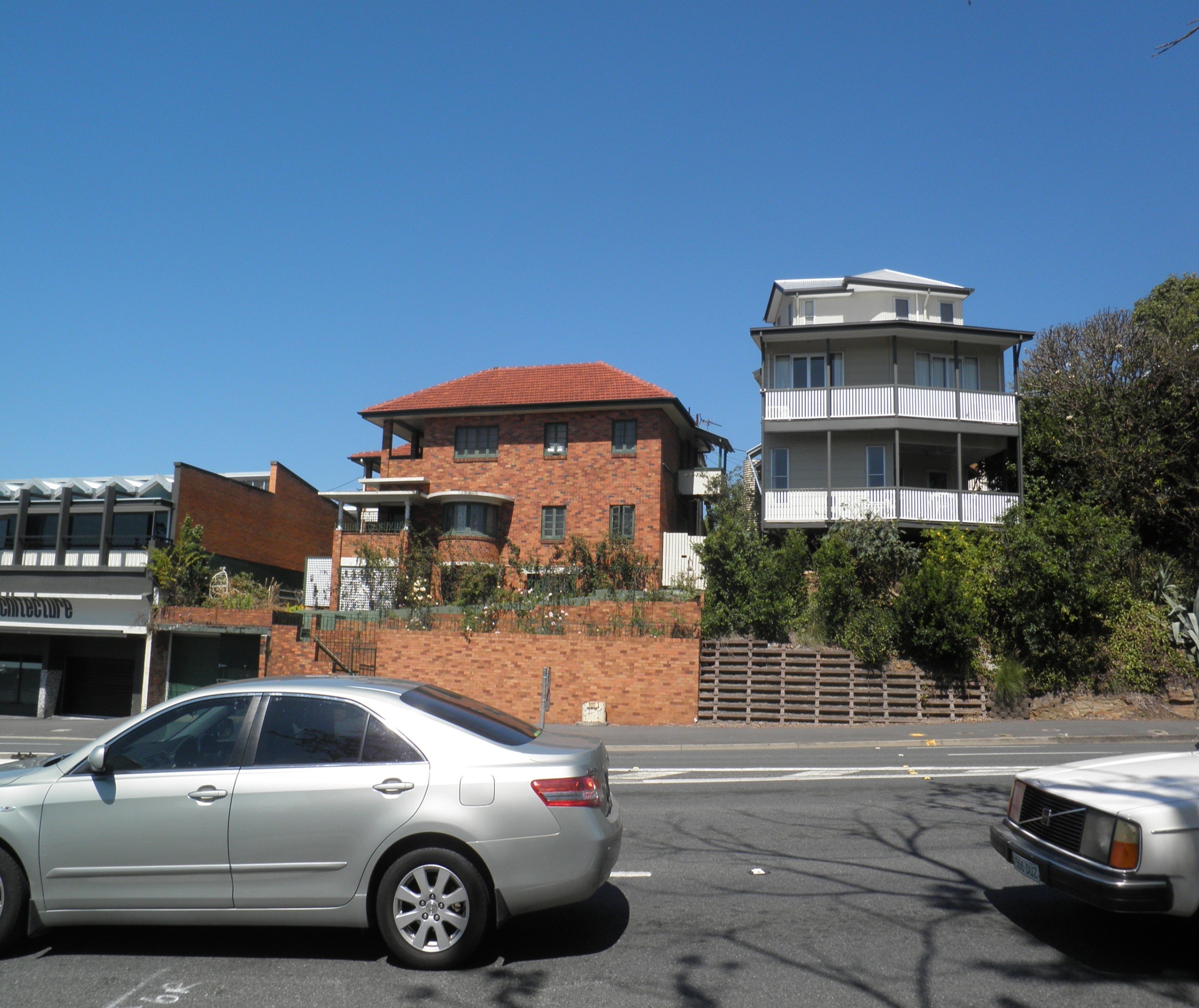Addresses
Type of place
Flat building
Period
World War II 1939-1945
Style
Queenslander
Addresses
Type of place
Flat building
Period
World War II 1939-1945
Style
Queenslander
‘Warren Lodge’ is a set of six brick flats constructed on a high ridgeline above the Normanby Fiveways on Musgrave Road, Petrie Terrace. Built by owner, Ernest Frank Morley, the brick flats display elements of Functionalist architecture, popular at the time. ‘Warren Flats’ are important in demonstrating Brisbane’s development pattern in the early 1940s, in particular Petrie Terrace, and the way in which ideas about acceptable forms of housing were changing.
Also known as
Charleston Mews
Lot plan
Key dates
Local Heritage Place Since —
Date of Information —
Construction
Roof: Tile;Walls: Face brick
Criterion for listing
(A) Historical; (E) AestheticInteractive mapping
Also known as
Charleston Mews
Lot plan
Key dates
Local Heritage Place Since —
Date of Information —
Construction
Roof: Tile;Walls: Face brick
Criterion for listing
(A) Historical; (E) AestheticInteractive mapping
History
As the Great Depression progressed in the late 1920s and into the 1930s a marked deficit of housing in Brisbane emerged. This was the period in which the multi-unit dwelling began to emerge as an alternative to the traditional Brisbane house and yard. Prior to this in larger Australian cities such as Sydney and Melbourne this style of ‘modern’ living, in blocks of flats, had become a stylish alternative to living in the traditional house.
In the early 1930s to cater for the housing shortage as well as to generate income many home owners in the inner-city suburbs converted houses into tenements, where tenants would share bathrooms, toilets and kitchens. This led to community concerns of overcrowding and increased hygiene problems. A fashionable and more sophisticated alternative to this form of accommodation was the purpose built block of self-contained flats. Marketed mainly at single people and childless couples the earliest self-contained flats in Brisbane were generally conveniently situated close to trams, trains and shopping facilities in inner-city suburbs such as Spring Hill, New Farm and Fortitude Valley.
The Brisbane City Council, in 1930, defined the flat as “a fully self-contained dwelling, with private kitchen, bathroom and water closet”. The flat was designed to be an independently functioning dwelling. Although seen as a sophisticated lifestyle, flat living was fairly uncommon in Brisbane in this period, with only 8.4% of Brisbane residents living in flats. This low percentage may be due to the economic constraints of the time as well as the perceived novelty of this style of living. Most interwar flats in Brisbane were architecturally designed and constructed from good quality brick and timber.
In 1941 Ernest Frank Morley and his wife Edith Lily Morley purchased several parcels of land along Musgrave Road, Petrie Terrace. Morley, a building contractor, built a new set of six brick flats on the site. It is unclear if he designed them himself or if they had an architect. In May 1941 the application for the construction of the flats was approved by the Brisbane City Council and was recorded to cost £2950. By 1943 the flats had been completed and the Morley’s were recorded in the Electoral Rolls as residing at ‘Warren Lodge’. The flats were designed with many Functionalist architectural features and were ideally situated close to the city and the Normanby Fiveways tramline.
‘Warren Lodge’ is important in demonstrating Brisbane’s development pattern in the early 1940s, in particular in Petrie Terrace, and the way in which ideas about acceptable forms of housing were changing.
Description
Warren Lodge is a highly intact two-storey face-brick set of flats with a tiled hipped roof fronting Musgrave Road and overlooking the Normanby Fiveways. It has rear access from St James Street at the upper level. It retains timber casement windows and the Musgrave Road elevation features a semi-circular bay window and square projected balcony with barley twist columns. The garden has a face brick retaining wall and original garden beds.
Statement of significance
Relevant assessment criteria
This is a place of local heritage significance and meets one or more of the local heritage criteria under the Heritage planning scheme policy of the Brisbane City Plan 2014. It is significant because:
References
-
Architectural and Building Journal of Queensland, March 1936 and editorial, 1938
-
Brisbane City Council Minutes, 1935-36, p.764 & 918 and 1938, p.605
-
Brisbane City Council, 1946 aerial photographs.
-
Brisbane City Council Metropolitan Water Supply and Sewerage Board, Detail Plans
-
Certificates of Title, Department of Environment and Resource Management
-
Surveyor-General’s Office. McKellar’s Official Map of Brisbane and Suburbs. Brisbane, 1895
-
Queensland Post Office Directories
-
Queensland Electoral Rolls
-
Register of New Buildings, Brisbane City Council May 1941
-
Bennett, Helen, “Being Modern: Living in Flats in Interwar Brisbane”, Queensland Review, v.13, no.2, 2006, p35-48
Citation prepared by — Brisbane City Council (page revised May 2021)

